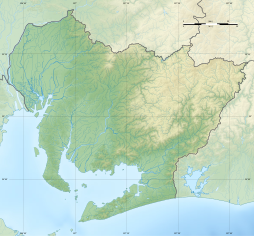Seto television tower
|
Seto television tower
瀬 戸 デ ジ タ ル タ ワ ー
|
|||||||
|---|---|---|---|---|---|---|---|
| Basic data | |||||||
| Place: | Seto | ||||||
| Prefecture: | Aichi | ||||||
| Country: | Japan | ||||||
| Altitude : | 108 m TP | ||||||
| Coordinates: 35 ° 11 ′ 43.7 " N , 137 ° 4 ′ 27.8" E | |||||||
| Use: | TV tower , radio station | ||||||
| Accessibility: | TV tower not open to the public | ||||||
| Tower data | |||||||
| Construction time : | 2002-2003 | ||||||
| Operating time: | since 2003 | ||||||
| Total height : | 244.7 m | ||||||
| Data on the transmission system | |||||||
| Last modification (transmitter) : | 2011 | ||||||
| Waveband : | FM transmitter | ||||||
| Radio : | VHF broadcasting | ||||||
| Send type: | Digital television | ||||||
|
|||||||
| Position map | |||||||
|
|
|||||||
The Seto or Seto Digital Tower ( Japanese 瀬 戸 デ ジ タ ル タ ワ ー , Seto Dejitaru Tawā ) is a 244.7 meter high transmission tower in the Japanese city of Seto . The tower, erected in 2003, was designed by the architects Nikken Sekkei . The tower is not open to the public. The tower was specifically designed to broadcast digital television .
history
The groundbreaking ceremony for the tower took place on June 6, 2002. The construction work was completed on August 20, 2003, so that the first broadcast tests for radio programs could be carried out on October 20. After the official closing ceremony, it was handed over to its destination on December 1, 2003. From August 3, 2004, the tower began broadcasting the programs with a 1 kW, it reached the full output of 3 kW on September 29, 2004.
After the switch from analog to digital television in 2011, the Seto television tower took over the broadcasting activities that had been carried out by the Nagoya television tower up until then .
description
The television tower, designed as a steel lattice tower, tapers towards the top, unlike most of its counterparts, not linear or concave, but convex. The half-timbered construction is based on three main pillars, each composed of two massive steel tubes. These support a vertically running core structure that is used as a duct. The frame construction is covered in white lacquer.
The system is cabled via a horizontal supply shaft on the ground that is connected to a base house. This belongs to the Seto Digital Research Park Center broadcasting station .
Frequencies and Programs
The Seto television tower serves the metropolitan area of Nagoya and thus almost all parts of Aichi prefecture as well as the Mie and Gifu prefectures and broadcasts the following television programs:
| Program name | channel | code |
Transmission power (kW) |
ERP (kW) |
Transmission area number of households |
|---|---|---|---|---|---|
| THK ( 東海 テ レ ビ 放送 ) | 21st | JOFX-DTV | 3 | 34 | 2.9 million |
| NHK E ( 名古屋 E テ レ ) | 13 | JOCB-DTV | 33 | 3.1 million | |
| NHK G ( 名古屋 総 合 ) | 20th | JOCK-DTV | |||
| CTV ( 中 京 テ レ ビ 放送 ) | 19th | JOCH-DTV | 34 | 2.9 million | |
| CBC ( 中部 日本 放送 ) | 18th | JOGX-DTV | |||
| NBN ( 名古屋 テ レ ビ ) | 22nd | JOLX-DTV | 34 | ||
| TVA ( テ レ ビ 愛 知 ) | 23 | JOCI-DTV | 1 | 5.1 | 2.3 million |
The polarization of the antennas is aligned horizontally.
Web links
- Seto TV Tower Information (Japanese)
- Information on the radiation power of the Seto TV tower (Japanese)
Individual evidence
- ↑ Towers designed by Nikken Sekkei Ltd. , accessed August 19, 2013
- ↑ 2012 International Symposium on Antennas and Propagation ( Memento of the original from October 29, 2013 in the Internet Archive ) Info: The archive link was inserted automatically and has not yet been checked. Please check the original and archive link according to the instructions and then remove this notice. , (PDF; 11.5 MB)
- ^ The Japan Times: Nagoya TV tower losing role, future iffy , July 2, 2011, accessed August 19, 2013
- ↑ until March 31, 2013: JOAR-DTV


